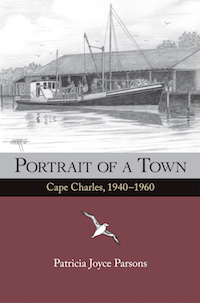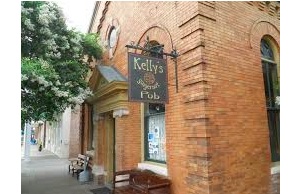REVIEW: Cape Charles in the Good Old Days

Pat Parsons lived in Cape Charles from 1940-1960 and reveals warts and all before the town was considered “quaint.” (Wave photo)
By GEORGE SOUTHERN
Cape Charles Wave
June 8, 2015
Roberta Romeo hears a lot of idle chatter among her customers at the Cape Charles Coffee House, but thanks to a chance comment last year, the town has a new, entertaining, reminiscence of the good old days — specifically, the decades just before Cape Charles entered a long downward spiral.
Portrait of a Town: Cape Charles, 1940-1960 is the title of a book by Patricia Joyce Parsons recalling the years she lived here. And while she rightly gets the credit for writing the book, Roberta Romeo gets the credit for encouraging her to do it.
As the Wave reported last September, during breakfast one morning at the Coffee House, Parsons mentioned to Romeo that she was writing vignettes of growing up in Cape Charles in order to share her memories with her grandchildren. At Romeo’s urging, Parsons read one of her stories to her. Recognizing a talented writer, Romeo immediately urged her to publish a book, and promised to sell the book at the Coffee House.
Now the book has been published, and appropriately enough, Parsons will launch it at the Coffee House 5 p.m. Friday, June 12. It’s a chance to meet the author and get an autographed first edition. And there will surely be further printings, as the book promises to be a staple in gift shops on the Shore for years to come.
That’s because Parsons is no public relations hack — she portrays the town for what it was, warts and all. And that makes her book interesting, even fascinating, for those with a love for the Eastern Shore.
Anyone who grew up reading Laura Ingall Wilder’s Little House on the Prairie series will especially enjoy Parsons’ book, because while the locale is far removed from the prairie, the fresh, honest, easy-reading evokes Wilder’s style. Parsons tells it as she remembers it, and she has a gift for honing in on the interesting and skipping the mundane.
 CONTINUED FROM FIRST PAGE
CONTINUED FROM FIRST PAGE
In the chapter “Swimming Hole,” for example, Parsons relates that “In August of 1945, the city fathers arranged to have the existing swimming hole [in the Bay] dredged to make it larger and deep enough for diving. The next summer, I was nine years old, and allowed to go into the water myself. . . . That day, no one realized that the new improvement had created a strong undertow. I was the first swimmer to be sucked into it. Helpless to extract myself as I was drawn below, I tried to fight against the downward force. During my struggle to surface, I could see the events of my short life, like the projected images of a film, unrolling within my brain. Fortunately, before I drowned, I was pulled out of the vortex by Mary Catherine Ames, our family physician’s teenage daughter. . . . Unfortunately, several adults who were unaware of the undertow lost their lives in the swimming hole over the next few years.”
And so, tragically, history repeated itself with the drowning last summer of little Ace Horton, almost the same age as Parsons at the time, and who also apparently was sucked into a vortex near the fishing pier.
On a happier but still ironic note, Parsons writes that as a child, “I equated crabs with poverty. Crabs were so plentiful that the less fortunate could always catch enough to make a meal, as the crab shells scattered around their dwellings so clearly attested. I could not understand why my parents, obviously lacking the insight that I had into the lowly status of the crab, would drive miles up Route 13 to the Shickshinny Restaurant because they considered the crab cakes there such a delicacy.”
And now, of course, crab cakes are more expensive than steak.
At only 140 pages, the book can be devoured as one would a jar of peanuts or bag of potato chips. One page after the next, you really can’t stop. And don’t skip over the Preface, as readers often do. Here’s how it begins:
“Don’t tell anybody that you come from over here, Mama.” The year was 1975. My ten-year-old daughter and I had just arrived from our home in Richmond and were driving along the beachfront of Cape Charles, Virginia. Experiencing a surge of nostalgia, I turned away from her. Glancing through the car window toward the horizon of the Chesapeake Bay, I could see part of the beach upon which I had spent so many pleasant hours in my youth. It was now choked with a tangle of sea oats and wiry beach grasses. The boardwalk, where I used to sit to watch the sunsets on summer evenings, was deserted. The benches that once lined the beachfront were gone. We had turned off the town’s main street, with its boarded-up storefronts. Across the street, an empty, unused plot of land gave no indication that at one time, the town’s focal point, a bustling railroad/ferry complex, had thrived on that spot. Instead, an unattractive cement factory dominated the view. A few years before, my daughter had been enchanted with the area, but now she was ten, old enough to be embarrassed by the depressing sight of her mother’s former hometown.”
But Parsons concludes the Preface on an upbeat note: “Recently, I have returned to find that the community is slowly redefining itself. It now boasts a modest tourist industry, which has resulted in the renovation of a number of the old buildings that line a main street that once again contains shops as well as a couple of nice restaurants. An Irish pub occupies an old bank building. Some of the homes of former residents have been restored and are rented to vacationers who come to Cape Charles to enjoy the sun, the beach, deep-sea fishing, and tours of the wildlife preserve at nearby Kiptopeke. During the 1970s and 1980s, magazine and newspaper articles often referred to Cape Charles as a depressed community, or even as a ghost town. I now hear it called “historic,” “charming,” or “quaint.” Well, I lived in Cape Charles before it was considered charming or quaint, so for those who have just been introduced to Cape Charles and wonder how and why this town existed in such a rural setting, for those who had to move away in order to earn a living, and for those who stayed and care to reminisce, here are a few snapshots of life in Cape Charles before it was “quaint.”
Want to read more from the book? A pre-publication chapter entitled “Liquid Refreshment” appeared in the Wave last September. CLICK to read.




















What a pleasure it was to read Portrait of a Town: Cape Charles, 1940-1960. Patricia Parsons brings Cape Charles to life with stories served up in well crafted vignettes. For the Eastern Shore local or the weekend traveler, this gem of a book is a great read!
I am anxious to read your book! Growing up in Cape Charles was lots of fun. It was such a friendly and close knit little community. Hope to see you Friday, Pat.
How can I get a copy of Pat Parsons book? I grew up in Cape Charles and would like the book. Please forward all information to order book, price, shipping time, etc.
The best place to buy the book is of course in town — either at the Coffee House or any number of other local shops that will surely be selling it. But out-of-towners can always go to Amazon (CLICK for link). –EDITOR